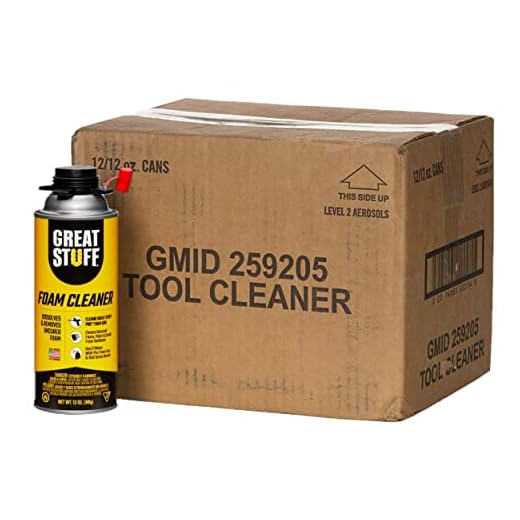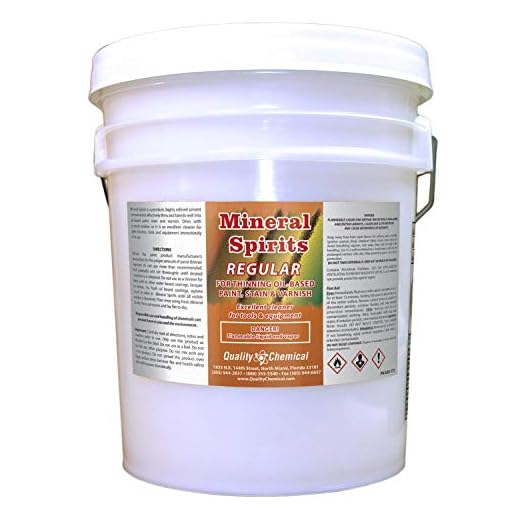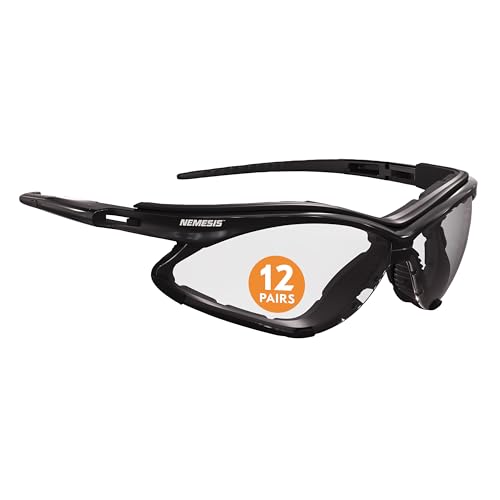




Using expanding foam insulation is a great way to seal gaps and cracks in your home, but sometimes accidents happen and the foam can set in your foam gun. It’s important to know how to properly clean your foam gun to ensure it works optimally the next time you need it. In this article, we’ll walk you through the steps to clean set expanding foam from your foam gun.
Step 1: Disassemble the foam gun
The first step in cleaning set expanding foam from your foam gun is to disassemble it. Carefully remove the nozzle, barrel, and any other removable parts from the gun. This will make it easier to access the foam and clean it thoroughly.
Step 2: Remove the foam residue
Once you have disassembled the foam gun, you will need to remove the foam residue. Start by scraping off as much of the set foam as possible using a plastic scraper or an old toothbrush. Be careful not to scratch or damage the gun while doing this.
Step 3: Use a solvent
If there is still some foam residue remaining, you can use a solvent to dissolve it. There are specific solvents available for removing expanding foam, such as acetone or a foam gun cleaner. Apply the solvent to a cloth and gently scrub the affected areas of the foam gun. Be sure to follow the instructions on the solvent’s packaging to ensure safe use.
Note: When using solvents, always work in a well-ventilated area and wear the appropriate safety equipment, such as gloves and goggles.
Step 4: Rinse and dry
After applying the solvent, rinse the foam gun thoroughly with warm water to remove any remaining residue. Make sure that all traces of the solvent and foam are removed from the gun. Once rinsed, dry the foam gun completely before reassembling it.
Step 5: Reassemble the foam gun
Once the foam gun is completely dry, reassemble all the parts that were removed in the first step. Ensure that they are correctly aligned and securely attached to the foam gun. This will prevent any leaks or malfunctions when you use the foam gun in the future.
By following these steps, you can effectively clean set expanding foam from your foam gun and keep it in optimal condition for future use. Remember to always take the necessary safety precautions when working with solvents and wear the appropriate protective equipment. Regular cleaning and maintenance of your foam gun will extend its lifespan and ensure its effectiveness when you need it most.
Removing Expanding Foam Residue
Removing expanding foam residue can be a tricky task, but with the right tools and techniques, you can effectively clean up any leftover mess. Here are a few steps to help you remove expanding foam residue from your gun:
1. Allow the foam to cure
Before attempting to remove the residue, you need to allow the expanding foam to fully cure. This typically takes around 8-24 hours, depending on the specific brand and type of foam. Trying to remove the foam before it has cured completely may result in a messier cleanup process.
2. Use a foam dissolver or cleaner
Once the foam has fully cured, you can use a foam dissolver or cleaner to loosen the residue. These products are specifically designed to break down expanding foam, making it easier to remove from surfaces. Follow the instructions on the product’s label for the best results.
3. Scrape off the residue
After applying the foam dissolver or cleaner, use a plastic scraper or putty knife to gently scrape off the residue. Be careful not to scratch or damage the surface underneath. You may need to repeat this step multiple times, depending on the amount of residue and how well it has bonded to the surface.
4. Clean the surface
Once you have removed as much residue as possible, clean the surface with warm soapy water and a sponge or cloth. This will help remove any remaining residue and ensure a clean finish. Rinse the area with clean water and allow it to dry completely before proceeding with any further repairs or touch-ups.
Remember, it’s important to wear protective gloves and safety goggles when working with expanding foam and its removal products. Always follow the instructions and safety precautions provided by the manufacturer to avoid any accidents or injuries.
Cleaning the Foam Application Gun
Properly cleaning the foam application gun is essential to keep it in good working condition. Residual foam left in the gun can harden and clog the nozzle, making it difficult to use in future projects. Here are the steps to clean your foam application gun effectively:
- Remove the foam canister from the gun by unscrewing it counterclockwise. Dispose of any remaining foam in the canister.
- Separate the gun’s front nozzle from the gun body. To do this, loosen the retaining nut located at the back of the gun body.
- Flush the gun body with a compatible solvent to remove any uncured foam. You can use a foam gun cleaner or a recommended solvent provided by the foam manufacturer.
- Clean the nozzle and other removable parts in a bucket of warm, soapy water. Use a brush to scrub away any excess foam residue.
- Rinse all the parts thoroughly with clean water to remove any soap or solvent residue.
- Dry the gun body and nozzle with a clean cloth. Check for any remaining debris or foam and remove it with a brush or toothpick if necessary.
- Apply a layer of lubricant to the gun’s metal components, especially the threads and needle. This will help prevent rust and keep the gun working smoothly.
- Reassemble the gun by attaching the cleaned nozzle to the gun body and tightening the retaining nut firmly.
- Screw a new foam canister onto the gun, following the manufacturer’s instructions.
Regular cleaning and maintenance of your foam application gun will ensure its longevity and prevent any issues during future projects. Be sure to follow the manufacturer’s guidelines and recommendations for cleaning products and procedures.
Removing Foaming Residue from Surfaces
After using expanding foam with a gun applicator, it is common to have foaming residue on surfaces where the foam has expanded beyond the intended area. It is important to remove this residue as soon as possible to prevent it from hardening and becoming difficult to remove. Here are some steps to effectively remove foaming residue from surfaces:
1. Wait for the foam to fully cure: Before attempting to remove the foaming residue, make sure that the expanding foam has completely cured. This usually takes around 8-24 hours, depending on the brand and type of foam used. Trying to remove the residue before it has fully cured can result in smearing and spreading the foam further.
2. Scrape off excess foam: Use a plastic scraper or putty knife to gently scrape off any excess foam from the surface. Be careful not to damage the surface while scraping. If the foam is still soft, it may come off easily in small pieces. If it has hardened, you may need to apply more pressure to remove it.
3. Use a solvent: If there is still residue left after scraping, you can use a solvent to dissolve and remove the foaming residue. Acetone or a specific expanding foam solvent are commonly used for this purpose. Apply the solvent to a clean cloth or sponge and gently rub the residue in a circular motion. Be sure to wear gloves and work in a well-ventilated area when using solvents.
4. Rinse with warm soapy water: After using a solvent, rinse the surface with warm soapy water to remove any remaining residue and solvent. Use a clean cloth or sponge to scrub the surface gently. Make sure to dry the surface thoroughly after rinsing.
5. Repeat if necessary: If there are still traces of foaming residue left on the surface, repeat the scraping and solvent process until the surface is clean. Some stubborn residue may require multiple attempts to remove completely.
Note: It is always important to read and follow the instructions provided by the expanding foam manufacturer for proper cleaning and removal techniques.
Using Solvents for Cleaning
If you are looking for an effective way to clean set expanding foam from your gun, using solvents can be a great solution. Solvents are chemicals that can dissolve or break down the foam, making it easier to remove and clean your gun.
Before using solvents, it is important to ensure that you are working in a well-ventilated area to avoid inhaling any harmful fumes. Also, make sure to wear protective gloves and goggles to protect your skin and eyes from any potential contact with the solvent.
1. Acetone
One commonly used solvent for cleaning expanding foam is acetone. Acetone is a strong solvent that can quickly dissolve the foam, making it easy to clean your gun. Using a cloth or sponge soaked in acetone, gently rub and wipe the foam from the gun’s surface. Repeat this process until all the foam is removed. After cleaning, make sure to thoroughly rinse the gun with water and dry it properly.
2. Mineral Spirits
Another solvent that can be effective for cleaning expanding foam is mineral spirits. Similar to acetone, mineral spirits can dissolve the foam and make it easier to remove. Simply apply the mineral spirits to a cloth or sponge and gently rub and wipe the foam from the gun. Again, rinse the gun with water and dry it thoroughly after cleaning.
It is important to note that when using solvents, it is crucial to follow the manufacturer’s instructions and safety guidelines. Some solvents may be flammable or have other specific handling instructions that need to be followed for safe usage.
Cleaning set expanding foam from your gun can be a challenging task, but using solvents can make the process much easier. Always exercise caution and follow proper safety measures when using solvents, and remember to properly dispose of any waste materials according to your local regulations.
Tools and Techniques for Cleaning
Cleaning set expanding foam from a gun can be a tricky task, but with the right tools and techniques, it can be done effectively. Here are some important tools and techniques to consider:
1. Protective Gear:
Before you start cleaning, it is important to protect yourself. Wear gloves, safety glasses, and a disposable coverall to avoid direct contact with the expanding foam and any cleaning solvents.
2. Solvent:
Choose a suitable solvent for cleaning the expanding foam. Acetone or a specialized expanding foam cleaner can be effective options. Ensure the solvent is compatible with the foam and the gun material before use.
3. Scraping:
Begin the cleaning process by scraping off any excess foam using a putty knife or a similar tool. Be careful not to damage the gun or surrounding surfaces while scraping.
4. Disassembly:
If possible, disassemble the gun to access all the parts that may have foam residue. Follow the manufacturer’s instructions for disassembly and reassembly, if available.
5. Soaking:
Soak the affected parts in the solvent for a recommended period of time. This allows the solvent to break down the foam and make it easier to remove. Use a container or a sealable bag for this process.
6. Brushing:
After soaking, use a soft-bristled brush or an old toothbrush to scrub away the remaining foam particles. Gently scrub the parts until they are clean and free from any foam residue.
7. Rinsing:
Rinse the parts thoroughly with clean water to remove any solvent or foam residue. Ensure all surfaces are rinsed properly to prevent any residue from affecting the gun’s performance. Dry the parts with a clean cloth or air-dry them.
8. Lubrication:
Once the gun and its parts are clean and dry, apply a lubricant to ensure smooth operation. Use a non-greasy lubricant recommended for the gun material to keep it functioning optimally.
By following these tools and techniques, you can effectively clean set expanding foam from a gun and maintain its performance and longevity. Remember to always read and follow the manufacturer’s instructions for cleaning and maintenance.
Preventing Foam Build-up on Gun
To prevent foam build-up on your gun and ensure optimal performance, follow these simple tips:
- Clean immediately after use: It is important to clean your gun immediately after use. Expanding foam can quickly harden and become challenging to remove once it dries. By cleaning it promptly, you can prevent foam from building up on the gun.
- Use a foam cleaner: Invest in a quality foam cleaner specifically designed for removing expanding foam. These cleaners are highly effective in dissolving and removing foam residues from the gun. Follow the instructions provided by the manufacturer to ensure safe and proper usage.
- Regular maintenance: Perform regular maintenance on your foam gun. This includes inspecting the gun for any foam residue or blockages and cleaning it thoroughly. By keeping your gun clean and well-maintained, you can prevent foam from accumulating and affecting the gun’s performance.
- Store the gun properly: When not in use, make sure to store your foam gun properly. This may include disassembling it and storing the parts separately or using a protective cover. Storing the gun in a clean and dry environment can help prevent foam from building up on the gun.
- Replace worn-out parts: Over time, certain parts of your foam gun may wear out or become damaged, leading to foam build-up. Regularly inspect the gun and replace any worn-out parts as necessary to maintain its performance.
By following these preventive measures, you can keep your foam gun clean and functioning optimally, ensuring consistent results and prolonging its lifespan.









